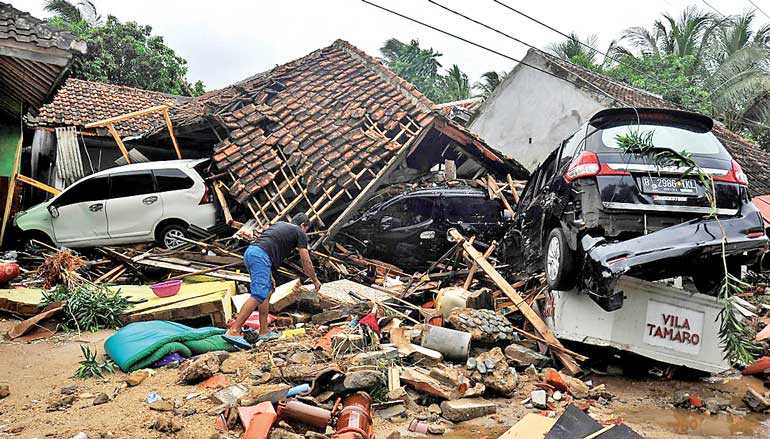Wednesday Mar 12, 2025
Wednesday Mar 12, 2025
Monday, 24 December 2018 00:00 - - {{hitsCtrl.values.hits}}

PANDEGLANG, Indonesia (Reuters) - A tsunami killed at least 168 people and injured hundreds on the Indonesian islands of Java and Sumatra following an underwater landslide believed caused by the erupting Anak Krakatau volcano, officials and media said yesterday.
Hundreds of homes and other buildings were “heavily damaged” when the tsunami struck along the rim of the Sunda Strait late on Saturday, spokesman for the disaster mitigation agency Sutopo Purwo Nugroho said.
Thousands of residents were forced to evacuate to higher ground. There was no estimate on the number of missing.
TV images showed the seconds when the tsunami hit the beach and residential areas in Pandeglang on Java island, dragging with it victims, debris, and large chunks of wood and metal.
On 26 December 2004, an Indian Ocean tsunami triggered by an earthquake killed 226,000 people in 13 countries, including more than 120,000 in Indonesia.
The eruption of Krakatau in 1883 killed more than 36,000 people in a series of tsunamis. Anak Krakatau is the island that emerged from the area once occupied by Krakatau which was destroyed in 1883. It first appeared in 1927 and has been growing ever since.
Saturday’s tsunami was the latest in a series of tragedies that have struck Indonesia, a vast archipelago, this year. Successive earthquakes flattened parts of the tourist island of Lombok, and a double quake-and-tsunami killed thousands on Sulawesi Island. Nearly 200 people died when a Lion Air passenger plane crashed into the Java Sea in October.
Authorities warned residents and tourists in coastal areas around the Sunda Strait to stay away from beaches and a high-tide warning remained in place through till 25 December.
President Joko Widodo, who is running for re-election in April, said on Twitter that he had “ordered all relevant government agencies to immediately take emergency response steps, find victims and care for the injured”.
Vice President Jusuf Kalla told a news conference the death toll would “likely increase”.
Rescue workers and ambulances were finding it difficult to reach affected areas because some roads were blocked by debris from damaged houses, overturned cars and fallen trees.
The waves washed away an outdoor stage where a local rock band was performing in Tanjung Lesung in Banten province, a popular tourist getaway not far from the capital, Jakarta, killing at least one musician. Others were missing.
The western coast of Banten province in Java was the worst-hit area, Nugroho told reporters in Yogyakarta. He said at least 35 people were reported dead in Lampung in southern Sumatra.
Around 250 employees of the state utility company PLN had gathered in Tanjung Lesung for an end-of-year event, company spokesman I Made Suprateka told Reuters. At least seven people were killed, and around 89 are missing, he said.
Dramatic TV footage showed the seconds when the tsunami hit a concert at the event and washed away the stage where local rock band Seventeen was performing.
“The water washed away the stage which was located very close to the sea,” the band said in a statement. “The water rose and dragged away everyone at the location. We have lost loved ones, including our bassist and manager... and others are missing.”
Coastal residents reported not seeing or feeling any warning signs, like receding water or an earthquake, before waves of up to two meters washed ashore, according to media.
But authorities said a warning siren went off in some areas.
Officials were trying to determine the exact cause of the disaster. Anak Krakatau, an active volcano roughly halfway between Java and Sumatra, has been spewing ash and lava for months. It erupted again just after 9 p.m. on Saturday and the tsunami struck at around 9.30 p.m., according to BMKG.
The tsunami was caused by “an undersea landslide resulting from volcanic activity on Anak Krakatau” and was exacerbated by abnormally high tide because of the full moon, Nugroho said.
Earthquake geologist and professor in the University of Michigan Ben van der Pluijm said the tsunami may have been caused by a “partial collapse” of Anak Krakatau.
“Instability of the slope of an active volcano can create a rockslide that moves a large volume of water, creating local tsunami waves that can be very powerful. This is like suddenly dropping a bag of sand in a tub filled with water,” he said.
Neighbouring Malaysia and Australia both said they were ready to provide assistance if needed.
Discover Kapruka, the leading online shopping platform in Sri Lanka, where you can conveniently send Gifts and Flowers to your loved ones for any event including Valentine ’s Day. Explore a wide range of popular Shopping Categories on Kapruka, including Toys, Groceries, Electronics, Birthday Cakes, Fruits, Chocolates, Flower Bouquets, Clothing, Watches, Lingerie, Gift Sets and Jewellery. Also if you’re interested in selling with Kapruka, Partner Central by Kapruka is the best solution to start with. Moreover, through Kapruka Global Shop, you can also enjoy the convenience of purchasing products from renowned platforms like Amazon and eBay and have them delivered to Sri Lanka.
Discover Kapruka, the leading online shopping platform in Sri Lanka, where you can conveniently send Gifts and Flowers to your loved ones for any event including Valentine ’s Day. Explore a wide range of popular Shopping Categories on Kapruka, including Toys, Groceries, Electronics, Birthday Cakes, Fruits, Chocolates, Flower Bouquets, Clothing, Watches, Lingerie, Gift Sets and Jewellery. Also if you’re interested in selling with Kapruka, Partner Central by Kapruka is the best solution to start with. Moreover, through Kapruka Global Shop, you can also enjoy the convenience of purchasing products from renowned platforms like Amazon and eBay and have them delivered to Sri Lanka.